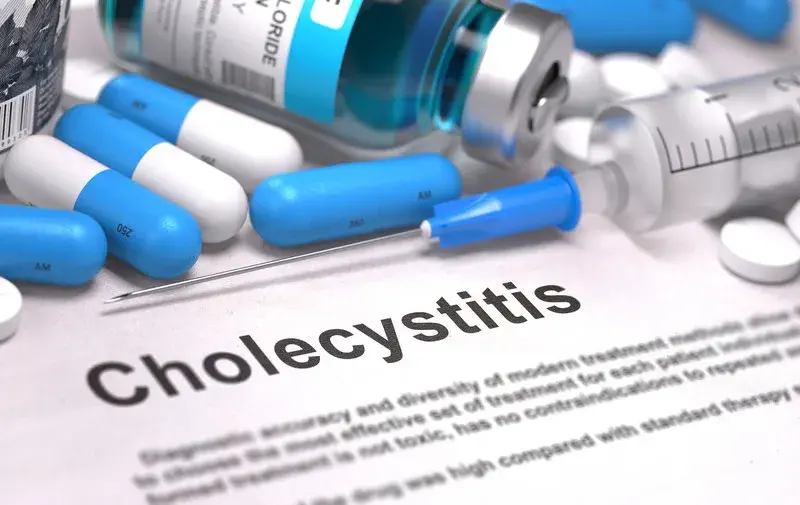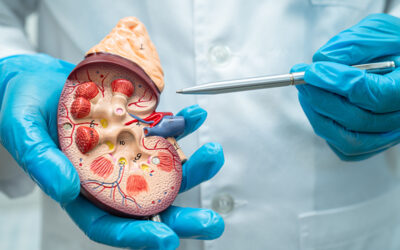About 20 million people in the USA (15% of the population) have gallstones, according to the World Gastroenterology Organization. Cholecystitis or gallstone disease occurs when gallstones crystallize (cholelithiasis) and block the release of bile from the gallbladder. In fact, cholecystitis is one of the most common disorders that medical coding and billing companies help gastroenterologists report. The primary treatment for gallstones that cause pain, inflammation, or infection is cholecystectomy or removal of the gallbladder. Today, gallbladder removal is done laparoscopically without requiring a large abdominal incision.
Acute Cholecystitis – Signs and Symptoms
Uncomplicated cholecystitis has an excellent prognosis. Upper abdominal pain is the most common symptom of acute cholecystitis. In addition to abdominal pain, patients may report nausea, vomiting, chills and fever.
Common uncontrolable risk factors for gallstone disorders include being female, being 60 years or older, being of Native American or Mexican-American descent, and family history. Modifiable lifestyle risk factors include obesity, high fat or high-cholesterol diet, and diabetes. Medical risk factors include being pregnant, taking medications to control cholesterol, and taking medications with high estrogen content.
Streamline your documentation and ensure accurate reimbursement with OSI’s medical billing solutions.
Click here for more information about our specialized medical coding services!
Diagnosis and Evaluation
Laboratory tests used to show evidence of gall bladder disease include liver tests, check of blood’s amylase or lipase levels, and complete blood count (CBC). However, the key diagnostic method used today is imaging. Radiology tests provide valuable information regarding the location of gallstones, as well as size and effect on organ function. The different types of imaging that gastroenterologists order to detect cholecystitis are:
- Abdominal ultrasound: This is the most common test performed to evaluate gallbladder abnormalities. Ultrasound shows signs of inflammation or indications that bile flow is blocked.
- Abdominal CT scan: By providing detailed images of the gallbladder and bile ducts, CT allows the physician to check for signsof blockage of bile flow.
- Magnetic resonance cholangiopancreatography (MRCP): This MRI exam identifies gallstones or blockage by providing detailed images of the liver, gallbladder, bile ducts, pancreas and pancreatic duct.
Treatment of Cholecystitis
Cholecystitis requires hospitalization. Treatment for acute cholecystitis is removal of the gallbladder or cholecystectomy. If there is a low risk of complications, the surgery is usually done as an outpatient procedure. The presence of complications such as gangrene or perforation of the gallbladder will require immediate cholecystectomy. Removal of the gall bladder will allow the bile to flow directly into the small intestine from the liver.
ICD-10 Codes for Gallstones (Cholelithiasis)
Compared to ICD-9, ICD-10 offers much greater specificity for reporting cholelithiasis with location, additional condition, nature of additional condition, and presence of obstruction:
K80 (cholelithiasis)
K80.0(calculus of gallbladder with acute cholecystitis)
- K80.00 (calculus of gallbladder with acute cholecystitis without obstruction
- K80.01 (calculus of gallbladder with acute cholecystitis with obstruction
K80.1 (calculus of gallbladder and other cholecystitis)
- K80.10 (calculus of gallbladder with chronic cholecystitis without obstruction)
- K80.11 (calculus of gallbladder with chronic cholecystitis with obstruction)
- K80.12 (calculus of gallbladder with acute and chronic cholecystitis without obstruction)
- K80.13 (calculus of gallbladder with acute and chronic cholecystitis with obstruction)
- K80.18 (calculus of gallbladder with other cholecystitis without obstruction)
- K80.19 (calculus of gallbladder with other cholecystitis with obstruction)
K80.2 (calculus of gallbladder without cholecystitis)
- K80.20 (calculus of gallbladder without cholecystitis without obstruction)
- K80.21 (calculus of gallbladder without cholecystitis with obstruction)
K80.3 (calculus of bile duct with cholangitis)
- K80.30 (calculus of bile duct with cholangitis, unspecified, without obstruction
- K80.31 (calculus of bile duct with cholangitis, unspecified, with obstruction)
- K80.32 (calculus of bile duct with cholangitis, without obstruction)
- K80.33 (calculus of bile duct with cholangitis, with obstruction)
- K80.34 (calculus of bile duct with chronic cholangitis, without obstruction)
- K80.35 (calculus of bile duct with chronic cholangitis, with obstruction)
- K80.36 (calculus of bile duct with acute and chronic cholangitis, without obstruction)
- K80.37 (calculus of bile duct with acute and chronic cholangitis, with obstruction)
K80.4 (calculus of bile duct with cholecystis)
- K80.40 (calculus of bile duct with cholecystitis, unspsecified without obstruction)
- K80.41 (calculus of bile duct with cholecystitis, unspecified, with obstruction)
- K80.42 (calculus of bile duct with acute cholecystitis without obstruction)
- K80.43 (calculus of bile duct with acute cholecystitis with obstruction)
- K80.44 (calculus of bile duct with chronic cholecystitis without obstruction)
- K80.45 (calculus of bile duct with chronic cholecystitis with obstruction)
- K80.46 (calculus of bile duct with acute and chronic cholecystitis without obstruction)
- K80.47 (calculus of bile duct with acute and chronic cholecystitis with obstruction)
K80.5 (calculus of bile duct without cholangitis or cholecystitis)
- K80.50 (calculus of bile duct without cholangitis or cholecystitis without obstruction)
- K80.51 (calculus of bile duct without cholangitis or cholecystitis with obstruction)
K80.6 (calculus of gallbladder and bile duct with cholecystitis)
- K80.60 (calculus of gallbladder and bile duct with cholecystitis, unspecified, without obstruction)
- K80.61 (calculus of gallbladder and bile duct with cholecystitis, unspecified, with obstruction)
- K80.62 (calculus of gallbladder and bile duct with acute cholecystitis without obstruction)
- K80.63 (calculus of gallbladder and bile duct with acute cholecystitis with obstruction)
- K80.64 (calculus of gallbladder and bile duct with chronic cholecystitis without obstruction)
- K80.65 (calculus of gallbladder and bile duct with chronic cholecystitis with obstruction)
- K80.66 (calculus of gallbladder and bile duct with acute and chronic cholecystitis without obstruction)
- K80.67 (calculus of gallbladder and bile duct with acute and chronic cholecystitis with obstruction)
- K80.7 (calculus of gallbladder and bile duct without cholecystitis)
- K80.70 (calculus of gallbladder and bile duct without cholecystitis without obstruction)
- K80.71 (calculus of gallbladder and bile duct without cholecystitis with obstruction)
K80.8 (other cholelithiasis)
- K80.80 (other cholelithiasis without obstruction)
- K80.81 other cholelithiasis with obstruction)
K81 (cholecystitis)
- K81.0 (acute cholecystitis)
- K81.1 (chronic cholecystitis)
- K81.2 (acute cholecystitis with chronic cholecystitis)
- K81.9 (cholecystitis, unspecified)
CPT Codes for Cholecystectomy – Removal of the Gall Bladder
The CPT codes for cholecystectomy (outpatient) effective January 1, 2018 are as follows:
- 47562 (laparoscopic cholecystectomy without cholangiography)
- 47563 (laparoscopic cholecystectomy with cholangiography)
- 47564 (laparoscopic cholecystectomy with exploration of the common bile duct)
- 47600 (cholecystectomy without cholangiography)
- 47605 (cholecystectomy with cholangiography)
- 47610 (cholecystectomy with exploration of the common bile duct)
- 47612 (cholecystectomy with exploration of common bile duct; with choledochoenterostomy)
- 47620 (cholecystectomy with exploration of common duct; with transduodenal sphincterotomy or sphincteroplasty, with or without cholangiography)
Coding Tips
Awareness of issues such as severity, laterality, specific location, chronicity, causation, and treatment encounter is crucial to ensure specificity in ICD-10 coding. The physician’s operative report should include everything done to care for the patient. An article in the June 1, 2016 Bulletin of the American College of Surgeons (ACS) cautions that medical coding service providers should read the physician’s operative report carefully to identify all valid diagnoses, or else it would lead to loss of revenue for the physician. The following example is given to illustrate this:
“If the a surgeon performs an open abdominal procedure and finds that the gallbladder is thickened and inflamed and must be removed, the operative note should include the finding of acute cholecystitis (K81.0) and a description of the cholecystectomy performed. If this finding is omitted from the postoperative diagnosis list, the coding staff should code it after finding it in the documentation.”
Physicians may perform certain other procedures with laparoscopic cholecystectomy procedures. The ACS also provides clarification on coding in such circumstances in its June 1, 2018 bulletin. To a question on a laparoscopic biopsy of the liver is performed at the same time as laparoscopic cholecystectomy, the article advises: “If these procedures were performed via an open approach, code 47600 (open cholecystectomy) would be reported with code 47001, Biopsy of liver, needle; when done for indicated purpose at time of other major procedure (List separately in addition to code for primary procedure), or code 47100, Biopsy of liver, wedge, as appropriate.”
So if a laparoscopic biopsy of the liver is performed at the same time as another laparoscopic procedure, unlisted code 47379 should be reported, as there is no CPT code for a laparoscopic liver biopsy. Surgeons should be aware that an unlisted procedure requires documentation that provides relevant information, including a proper definition/description of the nature, extent, and need for the procedure, and the time, effort, and equipment necessary to provide the service.
A laparoscopic cholecystectomy may be converted to an open cholecystectomy. In this case, the National Correct Coding Initiative Policy Manual for Medicare Services – Effective January 1, 2016 states that the physician should not report the failed laparoscopic cholecystectomy or a diagnostic laparoscopy. Only the completed surgical procedure may be reported. The endoscopic procedure is not separately reportable with the completed procedure.
Looking for accurate and efficient medical coding solutions for gallbladder disease and cholecystectomy procedures?
Partnering with an experienced medical coding outsourcing company can ensure accurate reporting of gastroenterology procedures. Such companies have experienced AAPC-certified coders who are knowledgeable about coding and billing guidelines for this specialty and can ensure accurate claims for optimal reimbursement.






